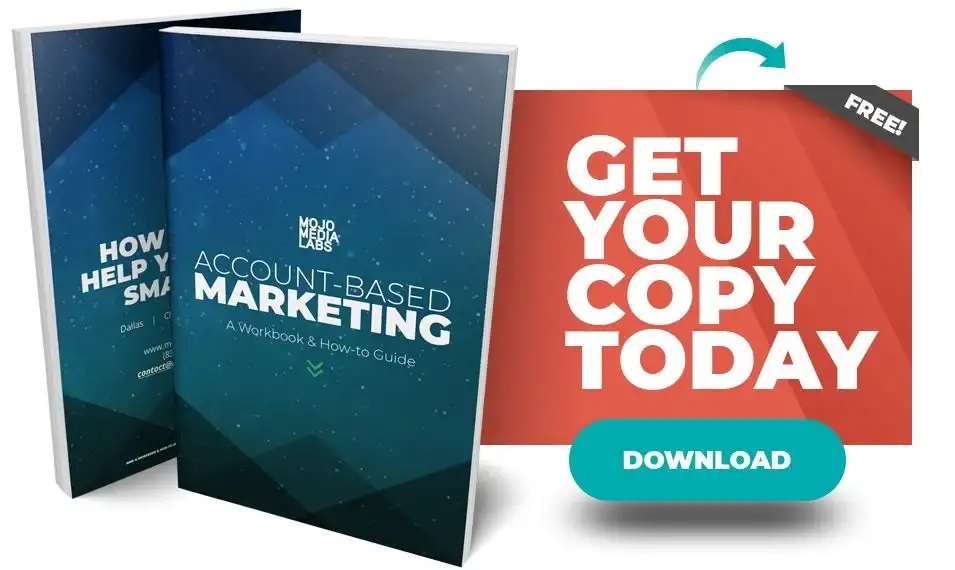Scoring, Grading, and Adjusting Sales and Marketing Practices for ABM
To continue our journey to account-based marketing success, one of the key tasks to complete is assessing your current organizational processes and understanding how they need to be adjusted to fit an ABM program. Now, this isn't to say your current setup isn't fantastic, but there are critical changes an organization must go through in order to become ABM ready. Adapting is a great skill to have anyway, so take the opportunity to learn more about it through this process!
To help set our course, we'll start by using what's called an ABM Maturity Model; essentially, this helps you benchmark your current status and gain insights into where you're going in your organization.

The model has 3 tiers: beginner, mid-level, and expert. These tiers denote readiness across 4 organization components that are vital to ABM success: Sales & Marketing alignment, Target Accounts, Marketing Programs, and Measurement. Don't worry if this feels a little confusing now, it will become more clear as we move through the chapter. To start, let's take a look at Tier 1 and its components.
Tier 1 Maturity: Beginner ABM
Remember, ABM is a strategic, scalable program that requires organizational alignment, so ensuring your business has a solid foundation makes growing your digital campaigns a much easier task in the future. Beginning with the basics, here is what you will need to qualify as Tier 1 ready for ABM.
Sales & Marketing Alignment
The goal for Tier 1 readiness in Sales and Marketing alignment is just that, foundational alignment and acceptance that ABM is going to be the primary program Sales and Marketing will collaborate on. This is the beginning of bridging the longstanding gap between Sales and Marketing, who traditionally have butted heads more often than not. To achieve Tier 1 readiness, Sales and Marketing will need to come together in the shared belief that account-based marketing will positively impact the business. Additionally, these two traditionally siloed departments will have to commit to collaboration, because ABM has no chance of success without Sales and Marketing working like a fine-tuned machine. This philosophical alignment sets the stage for the rest of the program.
Target Accounts
Target accounts are those which will receive your ABM marketing and sales efforts. Therefore, it is the task of Sales and Marketing to strategically assess current database accounts and strategically determine a starting list fueled by the Ideal Customer Profile. An easy way to begin this task is to select up to 50 accounts that have the largest contract potential for your business. This is key because ABM is all about hitting 3 business goals: increased closed new revenue, average contract size, and funnel velocity. Starting with a small list vetted by Marketing and Sales against the Ideal Customer Profile is a great way to solidify your baseline and leave room to scale.
Marketing Programs
Switching from the mindset of lead quantity to target account quality can be difficult, especially since some Sales and Marketing will still attend to those inbound leads. However, these leads can also be a great place to start assessing and adapting your marketing programs. A strategic approach here would be to look at your bottom of the funnel and lead generation programs.
Assess the target accounts from these and determine what data can be appended through your marketing tech stack and how to optimize forms these accounts will engage with during your campaign by adding autofill technologies. These small adjustments at base level get the gears turning for later scaling and optimization for future target accounts and ensure you have the data to make the best personalization iterations possible.
Measurement
While Marketing has the biggest language shift when it comes to implementing an account-based marketing program, it is key to the program's overall success. You won't be measuring ABM tactic success overnight, so a great place to start is to work with Operations and translate current marketing campaign analytics or website analytics into accessible reports for all other areas of the business, specifically Sales and Leadership.
To do this, take your base metrics and begin to shift your measurement/ROI presentation. These metrics should include:
- CTRs
- Conversions
- Inquiries
- MQLs
Operations plays a key role in making your traditional campaign measurement analytics accessible across the organization, and this will help translate your results so everyone can remain aligned and on board.
Tier 2 Maturity: Mid-Level ABM
At mid-level maturity, organizations have their foundations set, full alignment, and are well on their way to scaling their current processes. Here's what your organization might look like at mid-level ABM maturity.
Sales & Marketing Alignment
You've got everyone on board, agreeing to collaborate for the greater good that is account-based marketing, so the next step is to take action. This is where operational alignment comes into play; decisions are made as a cohesive team, target account selection is well within reach or even in its beginning stages post-tier 1 readiness, and your ABM team is creating a planning and execution cadence. This means Sales and Marketing are working as one to ensure their strategic actions not only look good on paper in the planning stage but have room to grow and adjust during the execution phase of the ABM program.
Target Accounts
Tier 2 target account selection goes beyond your current database and begins to explore the world of look-alike targeting. This entails Sales and Marketing collaborating on further optimization of the Ideal Customer Profile to include more common success traits, and use this updated Ideal Customer Profile to expand your database of target accounts to engage. This is also a great opportunity to begin scaling your target account list up to 5,000 target accounts, if possible. Much of your scaling process will depend on the capacity of Sales and Marketing, specifically in Sales as territory assignments are adjusted. Just know that this is the time and place to begin scaling and using technology to expand beyond your current customer database into look-alike accounts.
Marketing Programs
Marketing programs in tier 2 evolve from basic digital campaigns into full-funnel digital sales enablement and marketing tactics. This is where ad platforms come into the picture to improve attraction capabilities, website engagement delves into personalization and further optimization opportunities, and marketing automation platforms align with CRM data to provide the most personalized, high-touch experience for target accounts to work in parallel to Sales tactics. The personalization and automation elements are key because they signify a growing program that requires scaling and more help beyond manual duties of Sales and Marketing.
Measurement
Measurement in tier 2 begins analyzing revenue performance, a long-time missing link between marketing and financials. Being able to accurately tie ABM efforts to ROI is a key benefit as marketing campaigns traditionally are difficult to tie into financial spending, making budgeting for Marketing and Sales together a little tricky. With ABM, measuring revenue performance includes analyzing lift, pipeline, and funnel velocity as they relate to ABM tactics and campaigns working alongside Sales. Remember, Marketing has the biggest task in translating its metrics into accessible organizational reports, but with the help of Operations, reporting on campaign metrics and now tying marketing efforts to ROI and revenue make it easy to see how ABM directly impacts the business bottom line.
Tier 3 Maturity: Expert-Level ABM
Strategic scaling, effective iteration, and full organizational alignment come easy to you now at Tier 3 maturity. From here, you can work to improve processes that generate growth and increase efficiency across all areas of the business. Here are your expert pieces of the ABM puzzle that signify tier 3 ABM readiness.
Sales & Marketing Alignment
As alignment evolves and team members bridge the gaps between previously siloed departments, being able to share and understand metrics driven by Sales and Marketing among both teams is a true sign of an expert-level ABM program. By having accessible reports and shared language to discuss metrics and goals, this allows both Sales and Marketing to have an easier time assessing the direct impact the ABM program has on business revenue. This also allows Sales and Marketing to continue collaborating and coming up with fresh ideas for scaling and addressing iterations with the ABM Leadership team.
Target Accounts
Using data-driven account selection with key insights is the primary tenet of an expert-level ABM target account process. This is where AI and machine-learning, data-driven platforms really take the reins and aid the target account selection process, up to 5,000 accounts. Any more than 5,000 can be a stretch even for enterprise companies purely because target account engagement is so high-touch and highly personalized. Anything more than those 5,000 can force Sales to step back on its tactics and not perform at its best. At the same time, this is absolutely the best opportunity for scaling and using AI to take more of the manual work and target account assessment off the shoulders of Sales and Marketing, allowing them to better use their time and resources in other ways.
Marketing Programs
Marketing programs in tier 3 successfully scale and blend the analog efforts with digital marketing. Due to the high quality of target accounts, efficiency implemented via technology within the program, and key insights gained throughout the course of the ABM program, Sales and Marketing can engage in the best analog and digital blend of target account interactions to hit business goals. This includes the previous tier 2 digital marketing tactics like website and advertising personalization working in tandem with the CRM and marketing automation's abilities to generate other personalized digital campaign pieces.
The differentiator for tier 3 readiness is the implementation of analog activities for Sales and Marketing's task of further enabling Sales to perform during these activities. This includes field events like tradeshows or VIP dinners and appearances at corporate events where known target accounts are in attendance to generate high-touch, personal interactions that guide target accounts to closing new revenue or upselling current contracts. The combination of analog and digital marketing programs allows Sales and Marketing to further collaborate, scale, and effectively hit business goals set at the launch of the ABM program.
Measurement
Measurement also takes a step towards increased financial relevancy by improving reports to relate ABM efforts directly to the three primary business outcomes: increased funnel velocity, average contract size, and closed new revenue. The shift and evolution from translating traditional marketing campaign metrics to tying these efforts directly to business outcomes is a major benefit of running an account-based marketing program in the first place, and serves to connect previously unknown tactics to financial statements with visible ROI, making it easier to adjust for budget and spending in the long run.
Assessing Your Current Sales and Marketing Practices
As mentioned in the beginning of this chapter, it is quite possible that you might currently rank Tier 1 for some aspects, and Tier 2 or 3 for others. This is not a cut and dry process, rather this is meant to provide insights into what account-based marketing looks like across four major aspects of your business and how it will need to scale to see long-term success.
If the current 4 segments do not resonate just yet within your business, be sure that as you assess your current practices to address the roles and activities within Sales, Marketing, and Operations. Those three departments will all need to align for ABM success, and being able to take a deep dive into their current processes to adjust for ABM is critical for your upcoming program.
Addressing the current state of your business and adjusting for ABM takes time, so be patient, budget accordingly, and work with your ABM Leadership team to keep making progress to become fully ABM-ready.
Only 2 chapters left before we reach the end of our ABM 'blog the book' journey! In Chapter 9, we're diving deep into the world of Sales, Marketing, and Operations technology platforms to ensure after you've addressed the current practices that you have the technology to back up your new ABM program.
One more thing... We're getting closer to our ebook release, and newsletter subscribers will be first on the list to get their exclusive copy. Sign up using the form below to subscribe to The Weekly Mojo, our weekly newsletter with the best digital marketing content delivered right to your inbox.
Get Your Weekly Mojo



